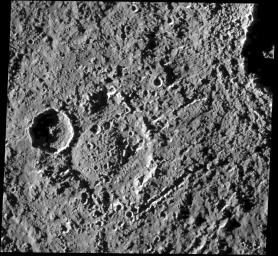
|
Har Crater on Callisto
- Click the image above for a larger view
- Full-Res JPEG (3600 x 3320) (1.3 MB)
- Full-Res TIFF (3600 x 3320) (5.2 MB)
Caption:
This image shows a heavily cratered region near Callisto's equator. It was taken by the Galileo spacecraft Solid State Imaging (CCD) system on its ninth orbit around Jupiter. North is to the top of the image. The 50 kilometer (30 mile) double ring crater in the center of the image is named Har. Har displays an unusual rounded mound on its floor. The origin of the mound is unclear but probably involves uplift of ice-rich materials from below, either as a "rebound" immediately following the impact that formed the crater or as a later process. Har is older than the prominent 20 kilometer (12 mile) crater superposed on its western rim. The large crater partially visible in the northeast corner of the image is called Tindr. Chains of secondary craters (craters formed from the impact of materials thrown out of the main crater during an impact) originating from Tindr crosscut the eastern rim of Har.
The image, centered at 3.3 degrees south latitude and 357.9 degrees west longitude, covers an area of 120 kilometers by 115 kilometers (75 miles by 70 miles). The sun illuminates the scene from the west (left). The smallest distinguishable features in the image are about 294 meters (973 feet) across. This image was obtained on June 25, 1997, when Galileo was 14,080 kilometers (8,590 miles) from Callisto.
Background Info:
The Jet Propulsion Laboratory, Pasadena, CA manages the Galileo mission for NASA's Office of Space Science, Washington, DC. JPL is an operating division of California Institute of Technology (Caltech).
This image and other images and data received from Galileo are posted on the World Wide Web, on the Galileo mission home page at URL http://galileo.jpl.nasa.gov.
Cataloging Keywords:
| Name | Value | Additional Values |
|---|---|---|
| Target | Callisto | Jupiter |
| System | Jupiter | |
| Target Type | Satellite | Planet |
| Mission | Galileo | |
| Instrument Host | Galileo Orbiter | |
| Host Type | Orbiter | |
| Instrument | Solid-State Imaging (SSI) | |
| Detector | ||
| Extra Keywords | Crater, Grayscale, Impact | |
| Acquisition Date | ||
| Release Date | 1998-03-26 | |
| Date in Caption | 1997-06-25 | |
| Image Credit | NASA/JPL/University of Arizona | |
| Source | photojournal.jpl.nasa.gov/catalog/PIA01054 | |
| Identifier | PIA01054 | |
